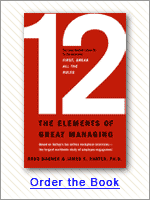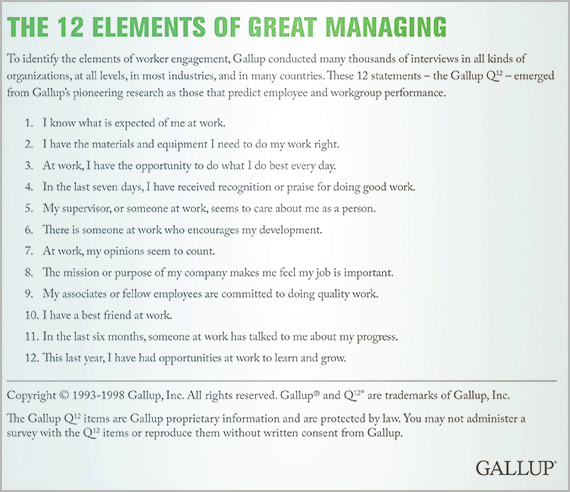Who needs a manager anyway?
Given all the experimentation with "self-managed teams" and the frequent examples of bad managers, it's a fair question. What exactly does a manager add to the equation? Maybe companies would be better off saving the money they pay supervisors or turning those people into non-management workers.
The answer lies in the very roots of free-market economics -- roots that reemerged more than a decade ago when Gallup went in search of the elements of work life that are most important to making a team productive and profitable.
 |
The central feature of a market economy is specialization of work. Unlike our ancestors generations ago, none of us today raises all his own food, builds his own house, and makes his own clothing. In fact, chances are good we don't even deliver by ourselves whatever our company sells. Most forms of production today are team efforts.
Since Adam Smith published The Wealth of Nations in 1776, it's been recognized that if each person concentrates on one part of the whole -- and each person's work is well coordinated with that of the group -- much more gets accomplished.
More than anything else, that need to coordinate or direct is what gives managers their jobs. It's the primary reason sports teams need a coach, orchestras need a conductor, and construction projects need a general contractor. Someone must put the pieces together.
Basics emerge from the research
When Gallup decided in the early 1990s to methodically prioritize all the aspects of work life by the degree to which each drove concrete performance, a most basic statement bubbled to the top: "I know what is expected of me at work." Employees who could answer most positively to that statement were most likely to come from productive teams. When answers were ambivalent or negative, the lack of job clarity often gummed up production.
When Gallup used this statement on employee surveys and tracked the results, substantial gains on "knowing what's expected" alone often correlate with productivity gains of 5% to 10%, thousands more happy customers, and 10% to 20% fewer on-the-job accidents. One electric utility solicits cost-reduction ideas from its employees, much like the suggestion boxes at many businesses. Of the recommendations implemented, the average idea adopted from its less engaged workers saves the company $4,000. The average idea from the most committed employees saves $11,000. Clearly, the more engaged workers put more brainpower into helping their business. Among all the aspects of life on the job, knowing what's expected plays the largest role in generating money-saving strategies at the utility.
Because of its ability to explain such wide variations in performance and because of its basic nature, Gallup identified this clarity of expectations as the First Element of Great Managing. (See "The 12 Elements of Great Managing" at the end of this article.) Yet for such a plain idea, finding the best way to orchestrate the work within a team has perplexed managers through the centuries.
On average, only about half of the employees in Gallup's international database "strongly agree" with this statement. The numbers are not impressively high even in stereotypically well-defined roles such as security personnel, sales, truck drivers, registered nurses, or production staff, where the figure ranges from just over half to almost two-thirds. The number drops to one-third for those in scientific, technical, and computer-related jobs. And it's amazingly common to find individuals making large salaries who will confide, "I really don't know what I'm supposed to be doing here."
The greatest pitfall of this element is that managers assume that the simplicity of the statement means that the issue requires only a basic solution: "If people don't know what's expected, I'll just tell them." This is analogous to American tourists who, not knowing the local language, speak English more slowly and loudly. And it's just as ineffective.
More than it seems at first glance
"Knowing what's expected" is more than a job description. It's a detailed understanding of how what one person is supposed to do fits in with what everyone else is supposed to do and how those expectations change when circumstances change. A good team, some say, is a lot like a great jazz band in which each player listens to the other instruments as he plays his own. The better they pay attention to the rest of the band and work their way into the music, the better the result.
 |
A contrasting example emerged several years ago when a group of managers from one Fortune 500 enterprise was beginning several days of training together. "As we go around the room," said the facilitator, "I'd like you to introduce yourself, tell us your job, and tell us how doing your job well increases the profits of your company." There were 25 managers in the room. Only five could make a credible connection between their jobs and the profits of the business. Had they been a jazz group as poorly organized, it would have sounded like the first day of fourth-grade band, with a lot of cacophonous honking and flipping through printed music.
Successful businesses become fat and complacent, creating enough layers of management and distance from the front lines that the First Element suffers among middle managers. Executives in particular must constantly ask themselves whether each man and woman in the organizational hierarchy has an essential and well-integrated set of responsibilities that advance the company. Unfortunately, such questions are usually asked only during cost-cutting initiatives, as they were one year later for the managers in that training session. After years of dubious value to the business, many were finally given pink slips.
The lesson from these disparate sources is that in a modern economy, managers fulfill an essential role, but only to the degree that they ensure every member of their teams understands how his work fits into the puzzle.
 |